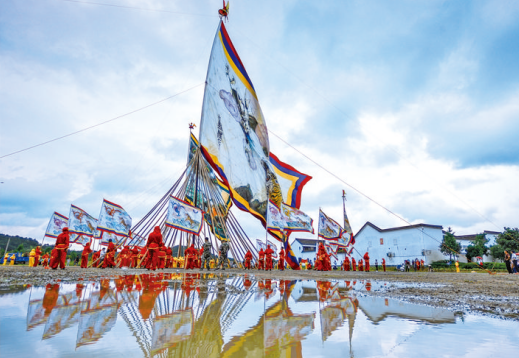发布时间: 2022-10-13

“I need to take time off from work to return home and sing local songs; without me, my village may lose at the contest,” says a video on the internet presenting a folk song tradition in the mountain villages of Guangxi. Similarly, in the hearts of villagers in Pan’an, the annual casting of large flags on the occasion of the Tea Market Temple Fair is a special event.
Ni Weimin, inheritor of the Flag Dancing in the village of Linggan, Shanghu Town, explained: “Usually, young natives of the village are asked to return home to take part in the Flag Dancing festival. Some may not visit their hometown very often, but during the Tea Market Temple Fair, they certainly return.”
Flag Dancing is a unique cluster of traditional folk events in China, which can be traced back to the Southern Song Dynasty. Since the Ming and Qing Dynasties, this has activity combined the legends of Qi Jiguang’s resistance to Japanese invaders and the Emperor Qianlong’s awarding of the Niang Flag. Along with the spread of its popularity, each village has also established a flag dancing association, which also organizes up to 36 flag dancing tournaments.
Flag Dancing is famous for the massive size of flagpoles and flags. The flagpole alone is up to 30 meters high, and the flag is huge, reaching up to an area of one mu. It takes between 80 and 100 strong men to work together to erect a large flag. Throughout the process, drums and songs accompany the ceremony.
It is extremely difficult to perform flag dancing. One of the crucial moves is “up-righting,” which requires a high degree of coordination and concerted efforts. After the flag is erected, the flag is ready to dance in the welcoming position. The action of “welcoming” (Flag Dancing is literally called “welcoming the flag” in Chinese; TN) is another technical difficulty which can also be dangerous. After moving in circles around the field, the flag is returned to its original position which requires everyone’s attention.
This group activity tests the ability of unity and cooperation, and it is essential to have reliable control of the whole situation. “Only experienced and prestigious people can serve as commanders, and there are also subordinate commanders at key points,” explained Ni Zhihua, another inheritor of Flag Dancing and commander at key point. At the age of 80 he has more than 30 years of experience and still insists on participating in the events. (Translated by Marco Lovisetto, edited by Daniel Haws)
| 1 | 2 | > | >> |

